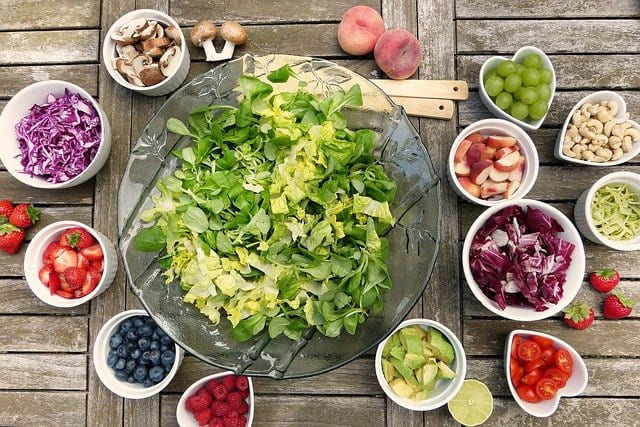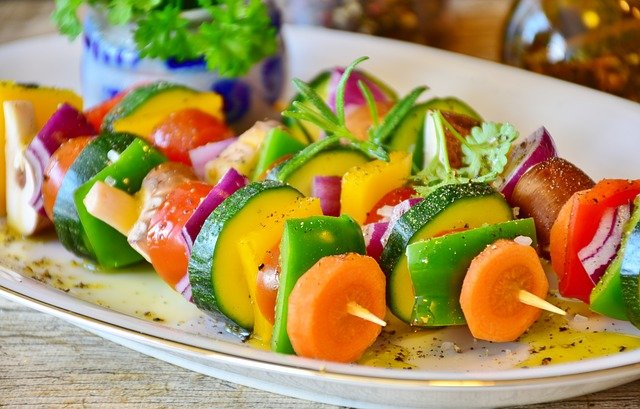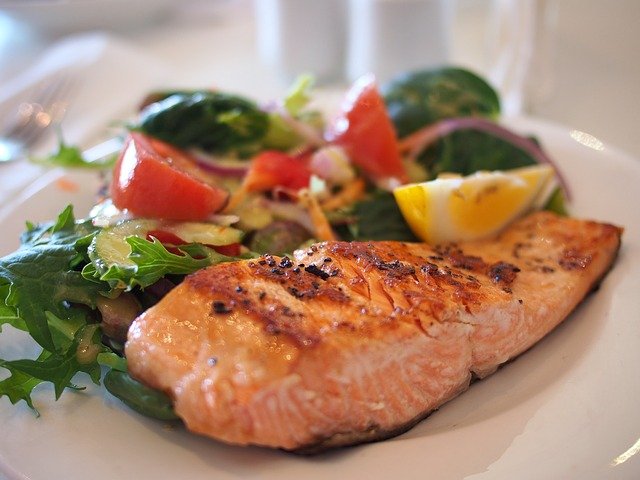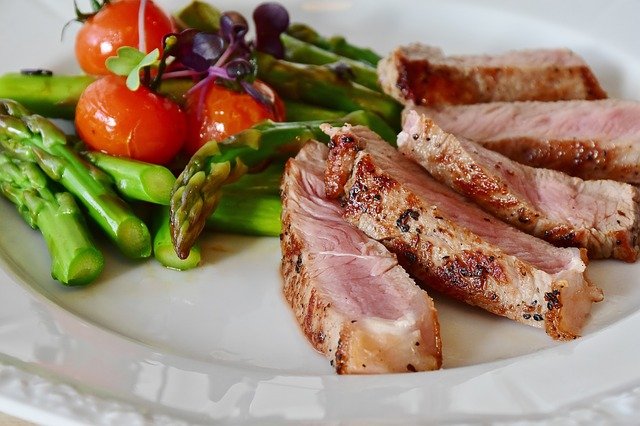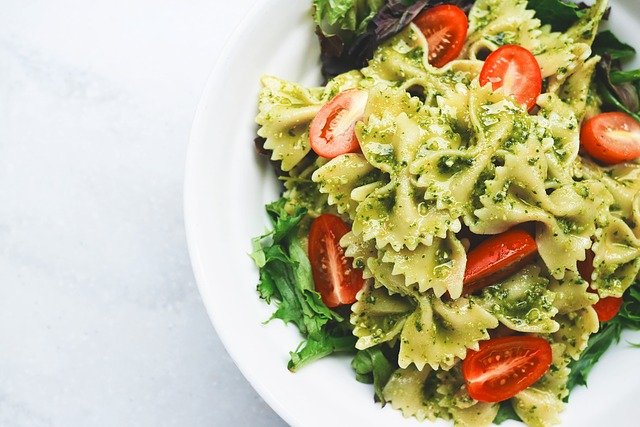
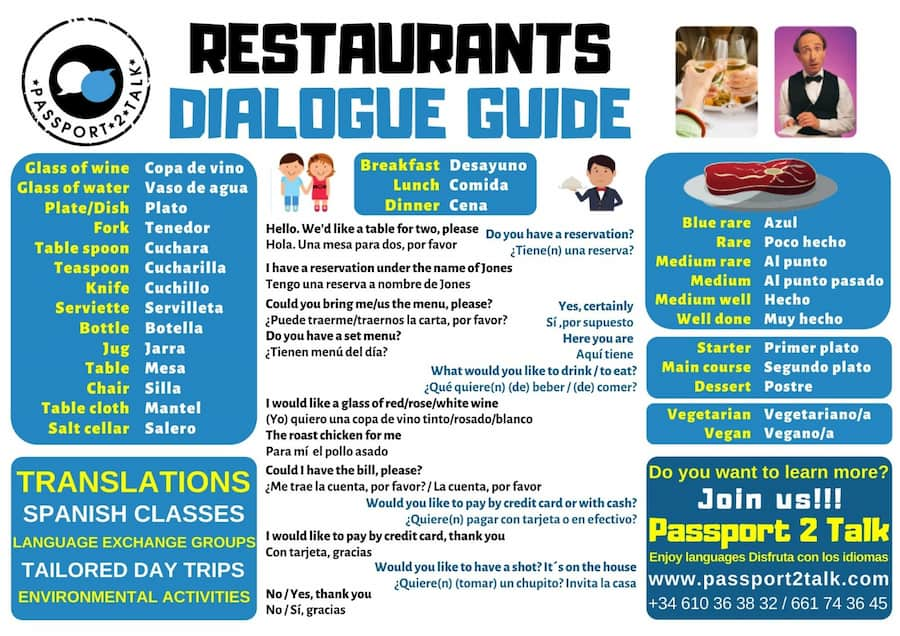
VOCABULARY 1: At the table – En la mesa
- Cliente: Camarero/a, perdone / disculpe. – Excuse me.
- Camarero: Sí, dígame. – How may I help you? (Tell me)
- Cliente: ¿Puede traerme un/unos…. (vaso/vasos)? – Can you bring me a/some….?
- Cliente: ¿Me puede traer una/unas….(botella/botellas)? – Can you bring me a/some….?
- Cliente: ¿Me trae…. ? – Can you bring me a/some….?
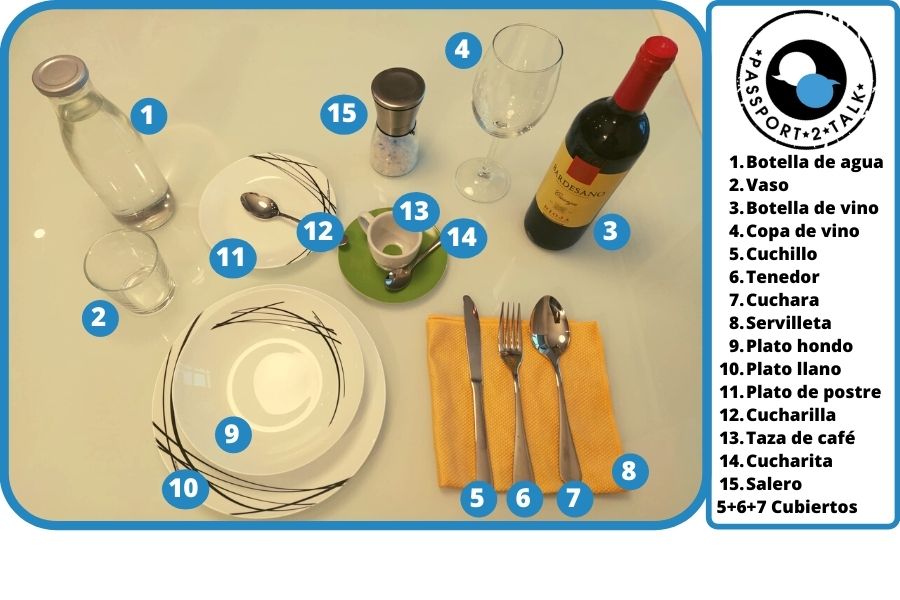
Diminutivo
Pequeño – small, pequeñito/a – tiny, dame el vaso pequeñito, dame la taza pequeñita.
Cuachara – spoon, cucharilla – tea spoon, chucharita – tea soon
VOCABULARY 2: Typical Spanish Food – Comida típica española
- Cliente: Camarero/a, perdone / disculpe. – Excuse me.
- Camarero: Sí, dígame.
- Cliente: ¿Puede traerme un/unos….? – Can you bring me a/some….?
- Cliente: ¿Me puede traer una/unas….? – Can you bring me a/some….?
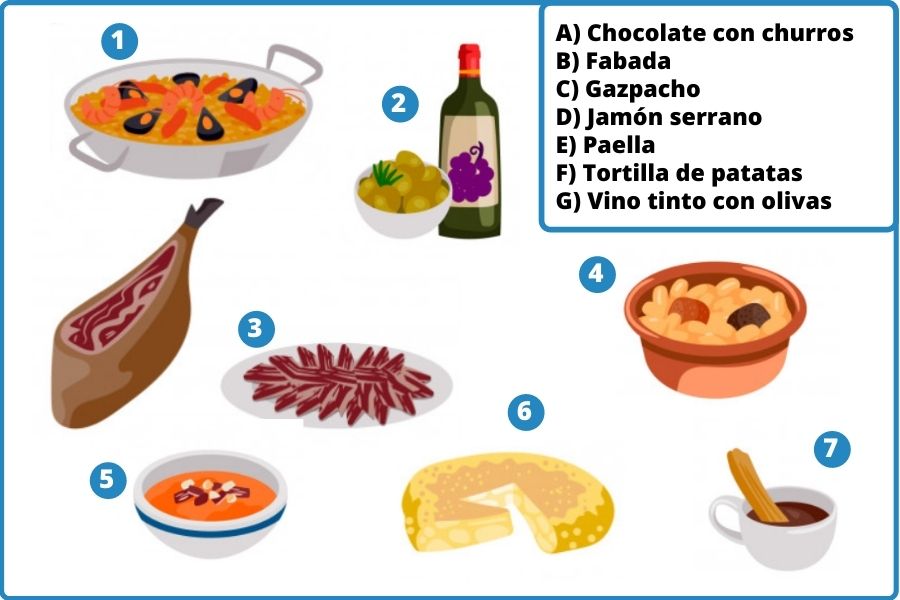
- Camarero: Señor, le gusta el ….. / la….
- Cliente: Sí, me gusta mucho.
- Camarero: Señora, le gustan los ….. / las….
- Cliente: Sí, me gustan mucho.
- Y a ti, ¿qué te gusta más? – What about you, which one do you like the most?

ROLE PLAY 1: Set menu – Menú del día
- ¿Qué te apetece comer? – What would you like to order?
- Elige lo que quieres pedir del menú – Choose what you would like to order from the set menu
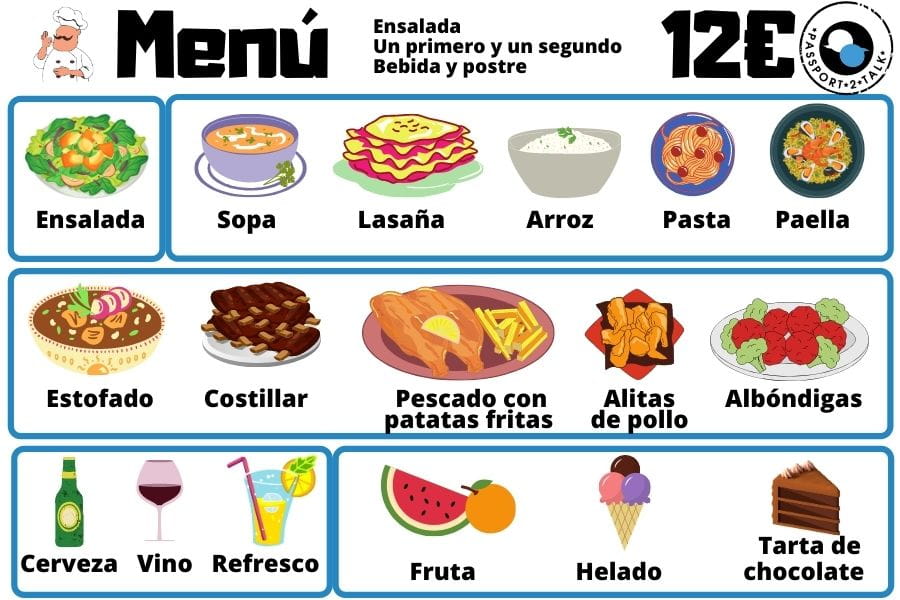
Homework class 1 – Deberes clase 1
LISTENING 1: Set menu – Menú del día
En el siguiente vídeo vas a escuchar un diálogo estándar entre el camarero y una pareja, descarga el PDF y rellena los huecos. – In the video below you will listen to a standard dialogue between the waiter and a couple, download the PDF and fill in the gaps.
Descarga el PDF para ver las soluciones al ejercicio. – Download the PDF to check your answers.
ROLE PLAY 2: Menu – Carta
- ¿Qué te apetece comer? – What would you like to order?
- Elige lo que quieres pedir de la carta – Choose what you would like to order from the menu

Exercise 1: Menu – Carta
At the fine dining restaurant. Only one customer.
En un restaurante elegante. Solo un comensal.
1. Presente (Simple Present in Spanish) Los verbos con la vocal en rojo son irregulares en presente. The verbs with red vowels are irregular in Present Simple Tense: To want–Querer e>ie, Can-poder o>ue, To recommend-Recomendar e>ie, To have- Tener e>i, To bring–Traer, To pass–Pasar, To give-Dar, To order-Pedir e>i, To hope-Esperar. Ejercicios en presente.
There are other ways to say the same sentences – Otras maneras de decir las mismas frases.
4. CLIENTE: Muchas gracias. ¿Puede traerme un poco de agua, por favor? ¿Podría traerme..?
5. CAMARERO: Aquí tiene. ¿Quiere pedir algo de aperitivo (de entrante, para picar)?
6. CLIENTE: Sí, ¿Puede traerme media ración de queso y jamón? por favor. Tráigame…
Quiero: presente I want.
Quería: imperfecto “I wanted”…I know that the restaurant has what I am asking for. This is a polite way of asking for something that is on the menu.
Querría: condicional I would like… I do not know if you have what I would like to order. This is a polite way of asking if they have something that is not on the menu.
11. CLIENTE: De segundo quiero la merluza a la vizcaína. De segundo voy a tomar….
13. CLIENTE: ¿Puede traerme la carta de vinos? por favor. ¿Me puede traer/ Podría traerme…?
15. CLIENTE: ¿Qué Rioja/Rueda/Jumilla/vino local me recomienda?
20. CLIENTE: Quiero pedir un postre. Me gustaría pedir (condicional) I would like to order…
22. CLIENTE: Quiero la tarta, por favor. Tráigame la tarta (imperativo) Bring me the cake, please.
VOCABULARY 3: Breakfast – Desayuno
- Camarero: Buenos días. ¿Qué quieren desayunar?
- Cliente: ¿Podría traernos un/unos….? – Could you bring us a/some….?
- Cliente: ¿Nos podría traer una/unas….? – Could you bring us a/some….?
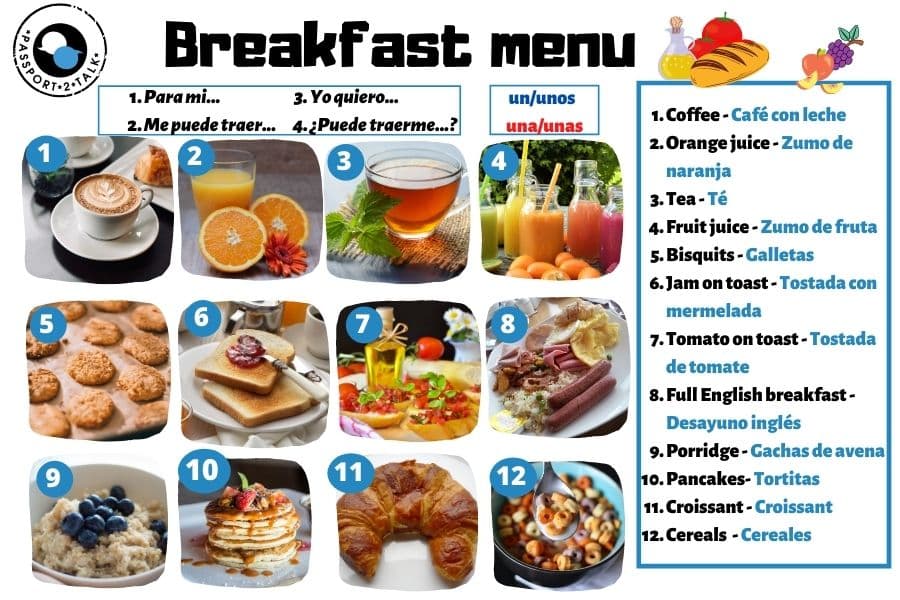
- Camarero: Señor, le gusta el ….. / la….
- Cliente: Sí, me gusta mucho.
- Camarero: Señora, le gustan los ….. / las….
- Cliente: Sí, me gustan mucho.
- Y tú, ¿qué desayunas normalmente? – What do you normally have for breakfast?
Usamos el presente para hablar de nuestra rutina.
We use Simple Present to talk about our routine
VOCABULARY 4: Meals – Comidas
- Camarero: Buenos días. ¿Qué quieren de comer / de primero / de segundo?
- Cliente: ¿Podría traernos un/unos….? – Could you bring us a/some….?
- Cliente: ¿Nos podría traer una/unas….? – Could you bring us a/some….?
- Cliente: Queríamos el/los/un/unos…. – We would like the/a/some…
- Cliente: Quería la/las/una/unas….? – I would like the/a/some…
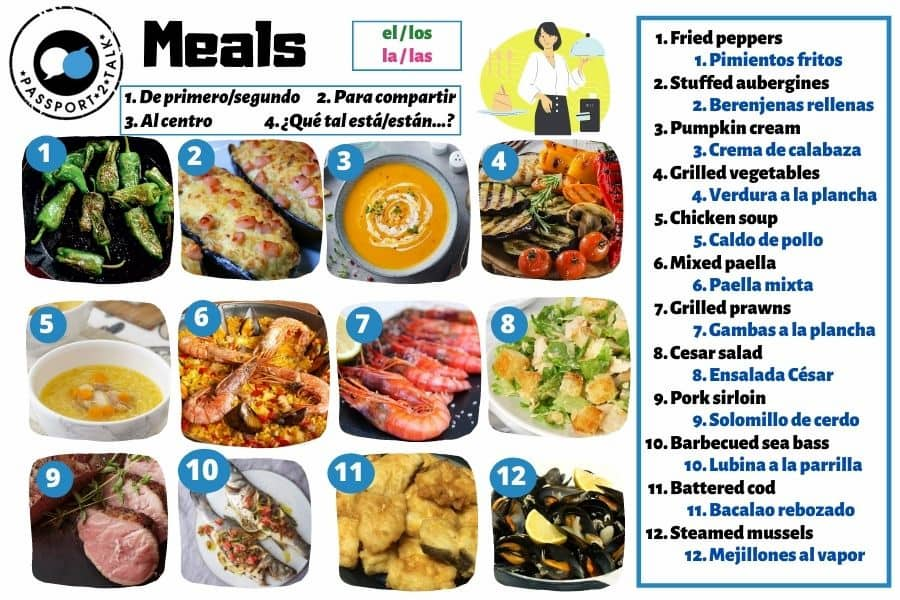
Meat – La carne vocabulary
VOCABULARY 5: The bill – La cuenta

VOCABULARY 6 – Complaints – Quejas
ACABAR DE…/ YA / TODAVÍA
Acabamos de pedir la bebida – We have just ordered the drinks.
Ya hemos pedido / Hemos pedido ya – We have already ordered.
Todavía no hemos pedido / No hemos pedido todavía – We have not ordered yet.
El camarero no nos ha tomado nota todavía – The waiter has not taken our order yet
SIGNIFICADO DE LLEVAR: to wear, to take, to bring, to carry, have been…-ing.
Llevo una camiseta – I am wearing a T-shirt
Me llevo el coche esta noche / Me lo llevo – I am going out tonight. I am taking the car.
Helena yo llevo el vino para la cena – I am going to bring the wine for the dinner
¿Puedes llevarme esta bolsa al coche?, es muy pesada –Can you carry this bag to my car? It is very heavy
Nosotros hemos estado esperando durante una hora – We have been waiting for one hour
Llevamos esperando (desde hace) una hora. We have been waiting for one hour
Llevo esperándote una hora – I have been waiting for you for one hour.
Llevo estudiando una hora – I have been studying for one hour
Llevan aprendiendo español tres años-They have been learning Spanish for three years
COBRAR-to charge / PAGAR-to pay
Write your own complaints and translate these:
To start to complain:
- Excuse me, Sir/Madam we have a problem….
- Sure, what is the matter?
- Don’t you like the fish?
- Didn’t you like the meat?
During the meal:
- We have been waiting for one hour. We haven´t ordered yet
- The soup is cold. Can/Could you warm it up?
- The meat is rare. Can/Could you cook it a bit more? Shall I/we cook it a little bit more?
- I’m afraid the fish is not fresh. Could you bring me the menu to order for something else?
- I have ordered/ordered chips, and you have brought me grilled vegetables
- There is a hair on my plate…. Could you please bring me another one?
- The chips are too oily
- The cocktail is very strong. Could you add an ice cube?
- The mash/mash potatoes is/are lumpy (bumpy, clumpy?)
- The rice is very dry, tasteless, bland (/person, situation: dull, boring).
- The curry is too hot/spicy for me.
- The tuna/cod is very salty.
- The broth is very fatty.
- The pineapple is too ripe.
- The stew is a little heavy; it has too much bacon and cold meats.
After the meal:
- The soup was a bit cold and the meat was overcooked/ overdone.
- The squid /the calamari were not fresh.
- No, I did not like the fish/squid.
- No, I did not like it/them very much. It was a little bland. They were a bit bland.
- No, I did not like the pasta/prawns.
- No, I did not like it very much. It was a little bland. They were a bit bland.
- We have been charged for an extra bottle of wine.
- Please cancel the dessert; we finished half an hour ago and we would like to leave.
- There was a mosquito in the salad
- I have just ordered a glass of wine and you have charged me/us two.
GRAMMAR: Verb+infinitive – Verbo+infinitivo

EXERCISES TO REVIEW – EJERCICIOS PARA REPASAR
VOCABULARY: At the table – En la mesa
- Cliente: Camarero/a, perdone / disculpe. – Excuse me.
- Camarero: Sí, dígame.
- Cliente: ¿Puede traerme/nos un/unos….? – Can you bring me/us a/some….?
- Cliente: ¿Me/nos puede traer una/unas….? – Can you bring me/us a/some….?
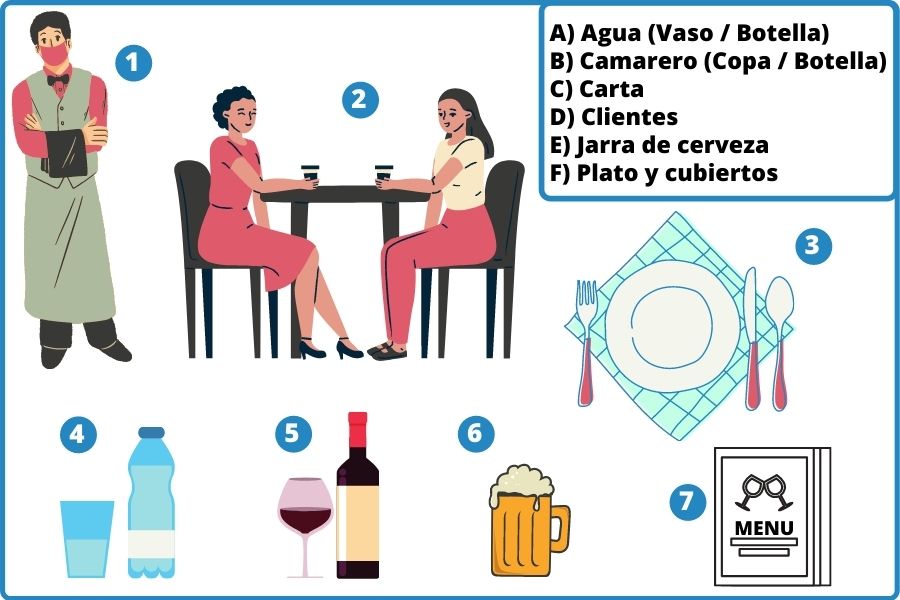
VOCABULARY: International food – Comida internacional
- Cliente: Camarero/a, perdone / disculpe. – Excuse me.
- Camarero: Sí, dígame.
- Cliente: ¿Puede traerme/nos un/unos….? – Can you bring me/us a/some….?
- Cliente: ¿Me/nos puede traer una/unas….? – Can you bring me/us a/some….?
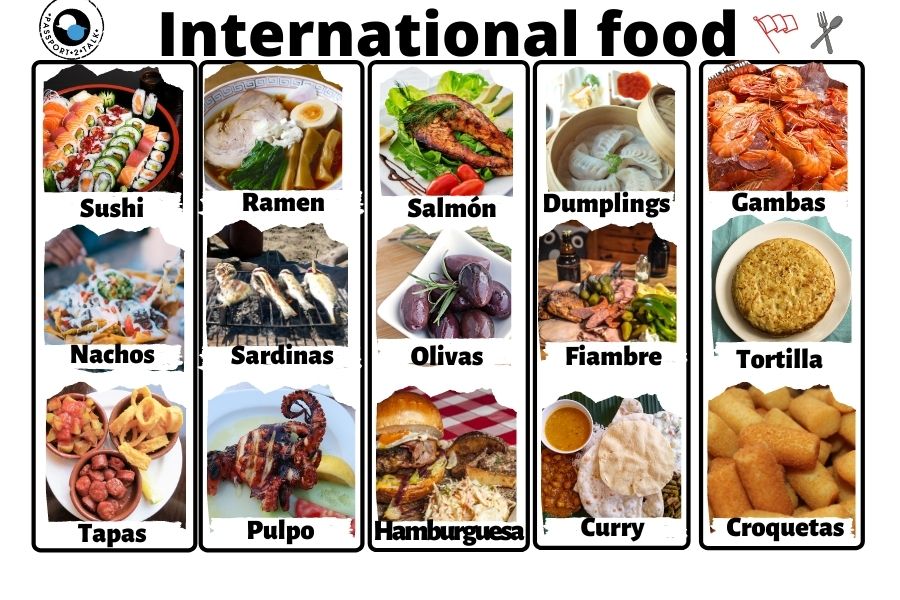
Exercise 2: Set menu – Menú del día
Dialogue at the restaurant – Diálogo en el restaurante
WRITE YOUR OWN DIALOGUE – ROLE PLAY: Menu – Carta
- Cliente: Camarero/a, perdone / disculpe. – Excuse me.
- Camarero: Sí, dígame.
- Cliente: ¿Podría traerme/nos un/unos….? – Could you bring me/us a/some….?
- Cliente: ¿Me/nos podría traer una/unas….? – Could you bring me/us a/some….?

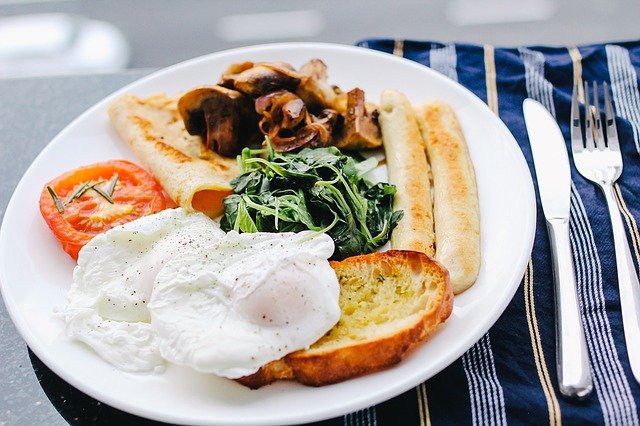
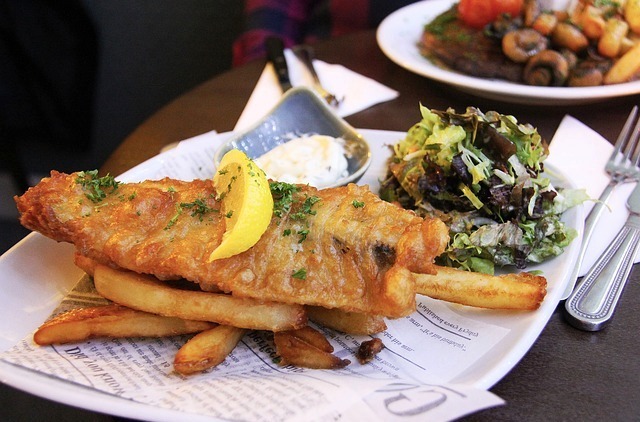

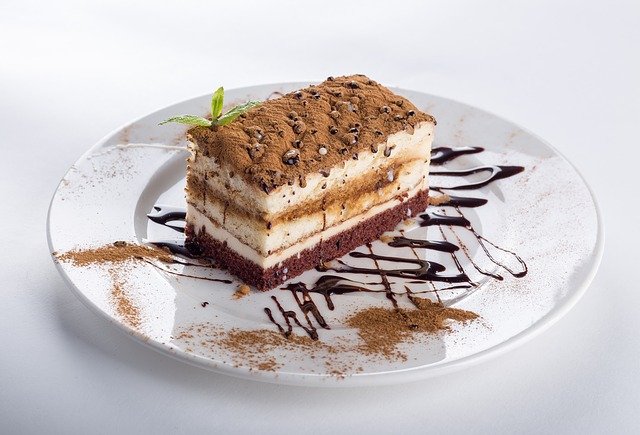

EJERCICIOS ONLINE Y AUDIOS:
- Aprenderespañol.org
- Profedeele.es: comidas y bebidas
- Profedeele.es: Las frutas
- Profedeele.es: Las verduras
- Profedeele.es: Los frutos secos
- Languagesonline.org.uk
- Learnspanishnow.co.uk: Los alimentos
- Learnspanishnow.co.uk: El desayuno
- Learnspanishnow.co.uk: La fruta
- Learnspanishnow.co.uk: Las verduras
- Learnspanishnow.co.uk: Medidas
- Learnspanishnow.co.uk: Vocabulario mesa
- Learnspanishnow.co.uk: Audio – Pedir en el restaurante
- VideoELE: Audio: Comer fuera (tapas)
- Audio: La comida
- Audio: Comida favorita de tu país
- Audio: Platos típicos españoles
- Audio: El tapeo en España
- Audio: Comer en España
- Audio: La tortilla de patatas
- Audio: Alboroto en el restaurante
- Audio español de Méjico: Mi postre favorito
- Audio: Hábitos de consumo


